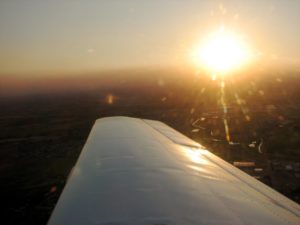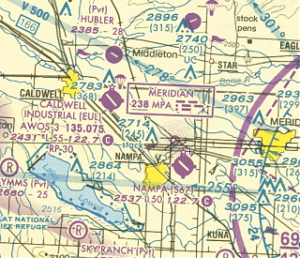
We’re still in the process of breaking in the new engine. It’s got about 15 hours on it and still running as smooth as silk. Today’s plan was to get up early and get in the air right around sunrise. The air would be nice and cool, plus the early start would help us avoid the flurry of activity that is typical for a beautiful Saturday morning like this one.
So Shiny
Last weekend we gave the Mooney a thorough wash and hand wax. That took quite a while for two of us to get done. Airplanes have a lot more surface area to clean than a car. Our hard work paid off this morning as we watched the sunrise paint the airplane in shimmering hues of purple, orange, pink and red.

Touring the Neighborhood
As a flight instructor I spend a fair amount of time flying around the local area, but the scenery of the Snake River, the Owyhee Mountains, and the Boise Mountains is still quite wonderful to view from the air. I hope I never get tired of just being in the air and enjoying the view. The scenery was especially good during the early morning light, and we took a few pictures. The usual disclaimer applies — the pictures never do justice to the way it really looked out the window.
May the Wind be at Your Back
…except when you are trying to take off or land in an airplane.

After finishing up our aerial tour of the Snake River and surrounding area we started to head back for our home airport of Nampa, Idaho. The nearby Caldwell Airport shares the same Common Traffic Advisory Frequency — this is the radio frequency used at non-towered airports for pilots to announce what they are doing. We heard a pilot announce, “Caldwell traffic, Cessna 123 is 5 miles north on the forty-five for 12, Caldwell.” That was a perfectly good radio call except the winds were blowing from 290 at 10 knots, strongly favoring landing in the opposite direction on runway 30 at Caldwell. Nancy and I both noticed the error, and we were hoping the pilot was actually going to land in the correct direction but perhaps just announced the wrong runway number in his initial radio call. No such luck. The same voice called out, “Caldwell traffic, Cessna 123 is on the downwind for 12, Caldwell.” I guess he didn’t notice the wind sock was pointing the wrong direction for landing on 12, that his ground speed was probably noticeably slower than normal on the downwind leg, and he certainly hadn’t listened to the automated weather information broadcast for the Caldwell airport.
Normally Caldwell is a pretty busy airport with several airplanes and helicopters in the traffic pattern. It was still pretty early this Saturday morning, and unfortunately the wrong-way pilot didn’t have anyone else in the pattern to help him get a clue and turn himself back around in the right direction. I am very hesitant to try to tell another pilot what to do over the radio. I’ve heard enough other people try to do so, and it’s almost never a productive conversation and just ends up clogging up the radio frequency. However, landing with a 10 knot tailwind is a really bad idea, especially in a light airplane. I had to speak up. Shortly after the wrong-way pilot made his downwind call, I keyed the microphone and said, “You may want to check the wind sock there at Caldwell.” I really don’t want to tell someone else how to fly their airplane over the radio, but I also really don’t want to see someone have a landing accident.
My radio call was greeted with silence. I took that as a good sign. Perhaps the pilot needed a few moments to take a look at the wind sock and figure out how we was going to maneuver the airplane safely to landing on runway 30 instead of 12. Both of us smiled when we finally heard his voice call back with, “Caldwell traffic, Cessna 123 … uh … turning … [pause] …” Ok that pause is a good sign. He just needs to figure what he wants to say on the radio to communicate his change of direction. “… uh base for 12 Caldwell.” Either he didn’t hear me, or didn’t care about the wind, but his plan was still to land with that tailwind. OK pal, good luck with that. The pilot announced he was on final for 12.

I tried to put him out of my mind as I worked on landing our airplane. Hold altitude until the airplane slows to 150 mph, gear lever down, start descending to pattern altitude. “Nampa traffic, Mooney 1UT is at the east end of Lake Lowell, at 5,000 planning to land on 29, Nampa.” Ok, maybe the other pilot was still on my mind as I emphasized the 29 in my radio call, hoping to give him one more hint about the winds. The pilot at Caldwell announced, “Caldwell traffic, Cessna 123 is uhh … doing a fly over at Caldwell.” Whew. OK, that’s not the right radio call for a go-around, but he got his message across. I was relieved that he didn’t attempt to land with 10 knots of wind at his back.